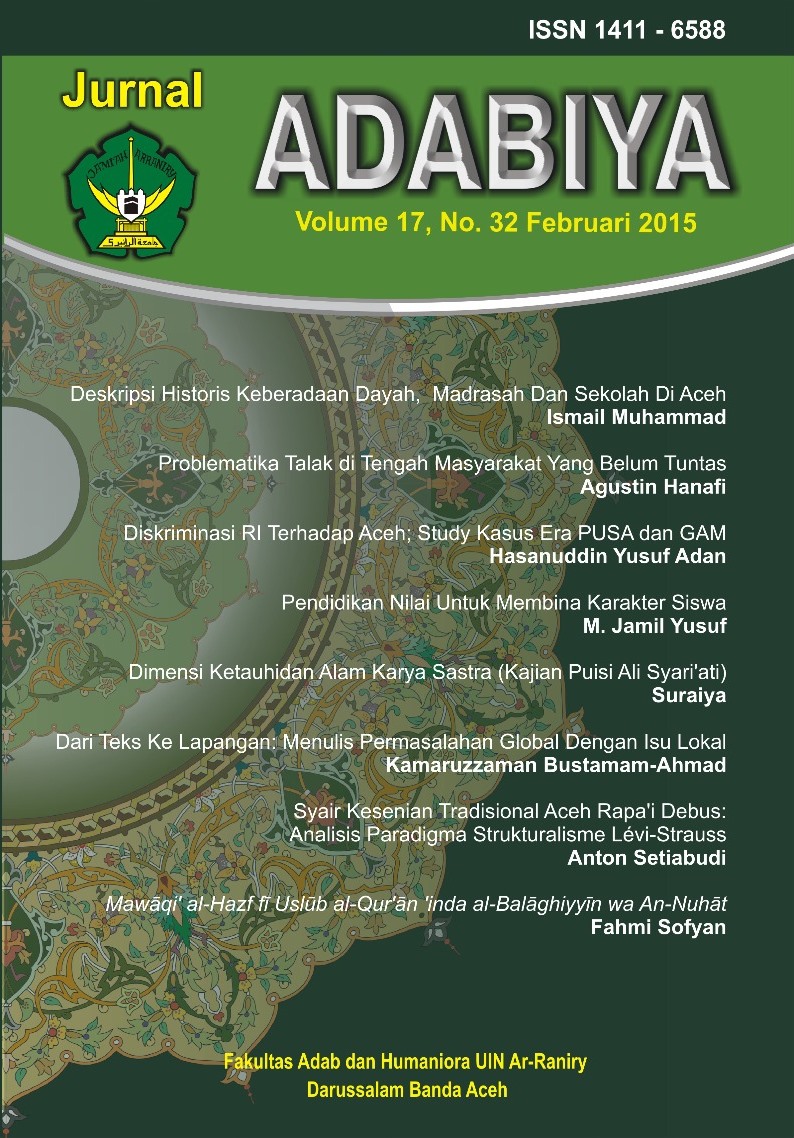TANBĪH AL-MĀSYI AL-MANSŪB ILĀ TARĪQ AL-QUSYASYĪ: Analisis Uslub Bahasa Arab dalam Karya ‘Abd Ar-Rauf As-Singkili
DOI:
https://doi.org/10.22373/adabiya.v18i35.1205Keywords:
Abdurrauf, TanbÄ«h al-MÄsyÄ«, uslub, bahasa Arab.Abstract
'Abd ar-Rauf al-Jawi al-Fansuri As-Singkili is a prolific scholar. He authored dozens of books in various fields and a variety of topics. Among his work written entirely in Arabic is al-MÄsyÄ« Tanbih al-MansÅ«b Tariq ila al-QusyÄshy. The text discusses the mysticism and monotheism, written around 1661 in Aceh. The text contains three forms of uslub, namely; uslub 'ilmi, uslub khitabi and uslub adabi. Uslub 'ilmi is more dominant in usage and more influential in the style of his thinking and writing than uslub khitabi adabi. There are lafadz tasybÄ«h, iqtibÄs, amr, nida’, tawkÄ«d, and others can be found in the three elements of uslub. The meaning of the uslub sentence itself depends on the contextDownloads
References
Muhammad Shaleh Putuhena, Historiografi Haji Indonesia, LKiS Pelangi Aksara Yogyakarta, 2007, hal. 115.
Abdurrauf tidak setuju dengan tindakan pengkafiran yang dilakukan oleh Nuruddin Ar-Raniry terhadap para pengikut Hamzah Fansuri dan Syamsuddin as-Sumatrani yang berfaham wahdatul wujud atau wujudiyah. Menurutnya, jika tuduhan pengkafiran itu tidak benar, maka orang yang menuduh dapat disebut kafir. Menurutnya, betapapun asyiknya seorang hamba terhadap Allah SWT, Khalik dan makhluk tetap memiliki arti sendiri. Ensiklopedi Islam, Ikhtiar Baru van Hoeve, Jakarta, 2005, hal. 34.
Content analysist adalah analisi isi atau pesan yang terdapat dalam tulisan atau teks, baik tulisan yang dibukukan (dicetak) atau tidak dibukukan seperti manuskrip atau naskah dan lain-lain.
D.A Rinkes, Abdoerraoef van Singkel; Bijdrage tot de kennis van de mystiek op Sumatra en Java, (Heerenven: Hepkema, 1909), hal. 25-26
Ph S. van Ronkel, Pasal pada Menyatakan Silsilah Tuan Syekh Abdul Rauf Tatkala Menuntut Ilmu Kepada Syekh Abdul Qusyasyi, dalam “Heit Jeiligdom to Oelakanâ€, (TBG: 1914), hal. 310.
A. Hasjmy, Syiah Dan Ahlussunnah Saling Rebut Pengaruh Dan Kekuasaan Sejak Awal Sejarah Islam Di Kepulauan Nusantara (Surabaya: PT. Bina Ilmu, 1983), hal. 112
P. Voorhoeve, Bayan Tajalli; Bahan-bahan untuk Mengadakan Penyelidikan lebih Mendalam tentang Abdurrauf Singkel, terj. Aboe Bakar (Banda Aceh: PDIA, 1980), hal. 3.
A. Hasjmy, “Syekh Abdurrauf Syiah Kuala, Ulama Negarawan yang Bijaksanaâ€, dalam Universitas Syiah Kuala Menjelang 20 Tahun, (Medan: Waspada, 1980), hal. 71.
‘Ali al-Jarim dan Musthafá AmÄ«n, al-Balaghah al-WÄdhihah (al QÄhirah: DÄr al Ma’Ärif, 1999), hal. 179.
QS al-AnbiyÄ’ [21] : 22
Ahmad al-HÄsyimi, JawÄhir al-BalÄghah FÄ« al-Ma’Äni wa al-BayÄn wa al-Badī’ (al QÄhirah: Maktabah al AdÄb, 2004), hal. 152.
BasyÅ«ni ‘Abd al FatÄh FaiyÅ«d, ‘Ilm al-Badii’ li UshÅ«l al BalÄghah wa MasÄ’il al-Badī’ (al QÄhirah: DÄr al Ma’Älim al TsaqÄfiyyah, 1998), hal. 268.
BasyÅ«ni ‘Abd al-FatÅ«h FaiyÅ«d, ‘Ilm al Ma’ÄnÄ« DirÄsah Balaghiyah wa Naqdiyah li-MasÄ’il al-Ma’Äni al-Juz al-TsÄnÄ« (al QÄhirah: Maktabah Wahbah, 1987), hal. 144.
Al Khatib al-Qazawayni, al-Iydhah fi ‘UlÅ«m al-BalÄghah (Beirut: DÄr al Kutub al ‘Ilmiyyah, 2003), hal. 203
Downloads
Published
Issue
Section
License
Procedure Proposed for Public Access Journals The authors of Jurnal Adabiya Journal adhere to the following terms:
a. Authors retain copyright and grant the journal the right of first publication, with the work licensed under a Creative Commons Attribution-ShareAlike 4.0 International License that permits others to share the work with attribution to the authorship and first publication in this journal.
b. Authors may enter into separate, additional contractual arrangements for the non-exclusive distribution of the journal's published version of the work (such as posting it to an institutional repository or publishing it in a book), with attribution to the journal's initial publication.
c. Authors are permitted and encouraged to submit their work online (e.g., in institutional repositories or on their website) before and during the submission process, as this can lead to fruitful exchanges and increased citations of published work (See The Effect of Open Access).
d. Jurnal Adabiya Journal publishes, distributes, uses, and repurposes scholarly works under the CC-BY SA license or an equivalent license.

